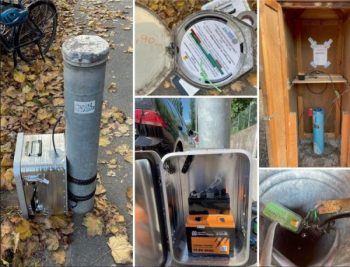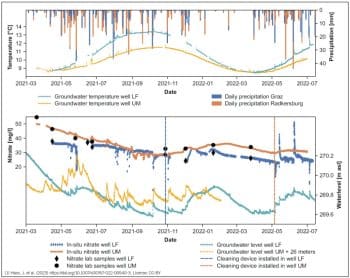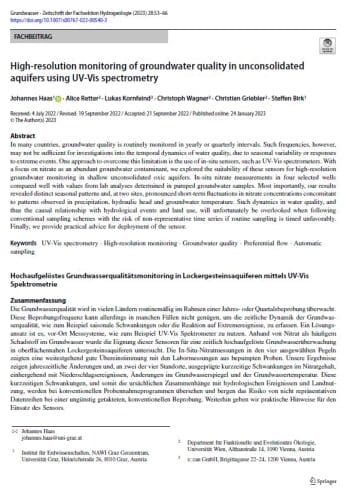A group of researchers together with s::can has applied UV-Vis spectroscopy to 4 unconsolidated aquifers to monitor seasonal fluctuations of nitrate concentrations. Find out more in this article with the attached scientific paper [1].
A scientific publication on using spectro::lysers to measure high resolution water quality data of groundwater

spectrolyser paper
The universities of Graz and Vienna (Austria) joined forces to monitor nitrate concentrations in unconsolidated aquifers using s::can spectro::lysers at high temporal resolutions. Their findings are summarized in an open access publication available since January 2023 [1].
4 spectro::lysers were set up to log the measurement data in the internal memory and operated directly from batteries only. Since groundwater is expected to be very clear, at first no automatic cleaning was installed for the sensors. The paper gives insights in how to setup the monitoring system from a very hands-on perspective such as what one should keep in mind when monitoring wells are used by different stake holders. Additionally, Haas et al. analyze the measured data that spans over several months.
The monitored data led to doubts on the pre-installed algorithms used to calculate the nitrate concentrations from the measured UV/VIS spectra. Especially in wells that showed abnormal high turbidity spikes the online data showed lower nitrate concentrations than the lab analysis. Further investigations of this circumstance revealed that the affected wells actually didn’t show real turbidity but (most likely) sedimentation of iron oxide flocs on the instruments’ windows which was compensated incorrectly by the built-in turbidity compensation of the instruments. Installing a brush cleaning system in one of the wells eliminated the “readings of turbidity”, however, the short-term fluctuations of nitrate readings that correlated with close-by rainfall events remained.
Additionally, s::can used the measured data to enhance the existing nitrate algorithms to also cope with the described “turbidity” events so that all data could be used for evaluation. The s::can nitrate algorithm performed well but a local calibration even further improved the correlation to lab data. The local calibration was performed on a pooled data set of 27 samples obtained from all four monitoring wells.

Summarizing the findings one can state that the two shallow wells showed considerable seasonal and event-based changes in nitrate concentrations (see figure above) which would be completely overlooked by a yearly or quarterly manual monitoring campaign. Especially the drop in nitrate concentrations caused by rainfall events and a recovery of nitrate concentrations within days hints to local recharge of the aquifer. Such findings have not been reported so far and offer valuable insights into nitrate dynamics. Compared to that the two deep wells showed less seasonal influence and no effect of rainfall.
Stay tuned for more as the monitoring campaign isn’t over yet. The four spectro::lysers are still deployed and measuring.
[1] Haas, J. et al. High-resolution monitoring of groundwater quality in unconsolidated aquifers using UV-Vis spectrometry. Grundwasser – Zeitschrift der Fachsektion Hydrogeologie (2023). https://doi.org/10.1007/s00767-022-00540-3, License: CC-BY
